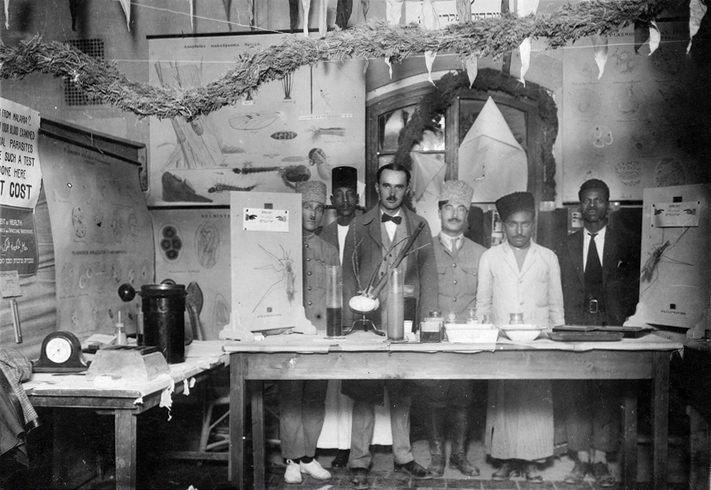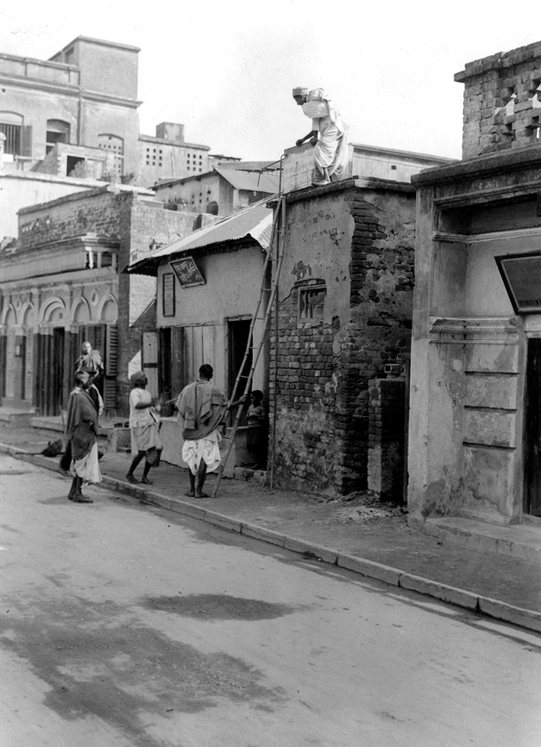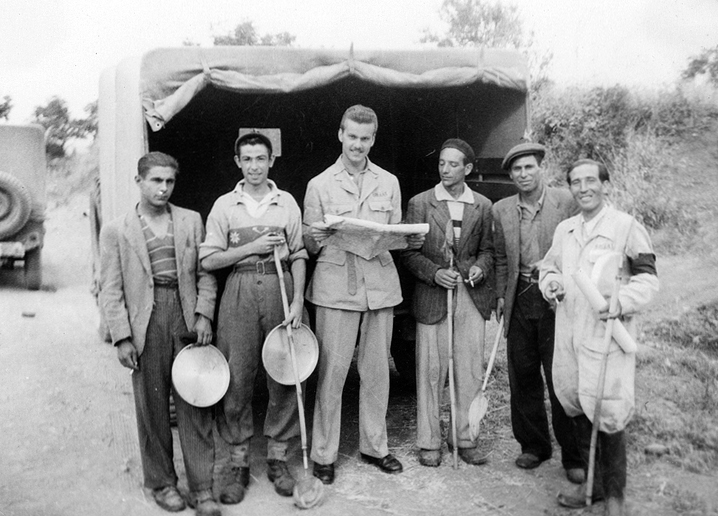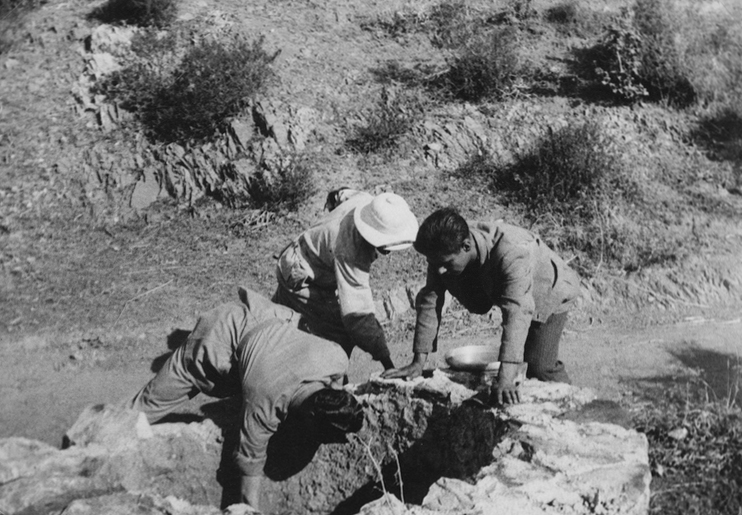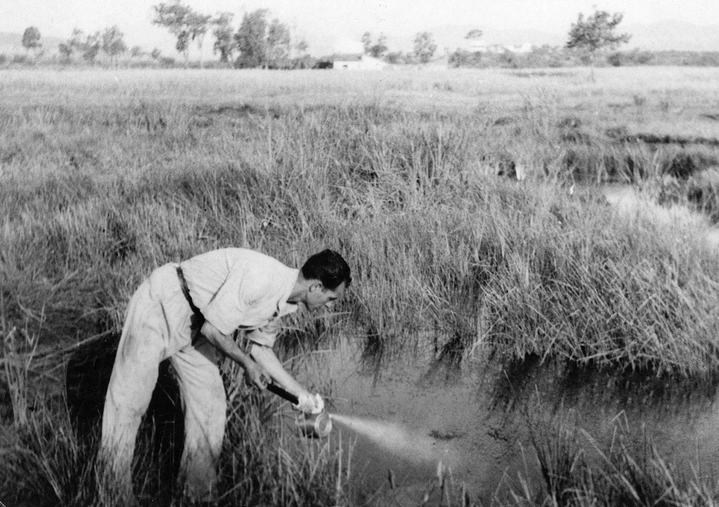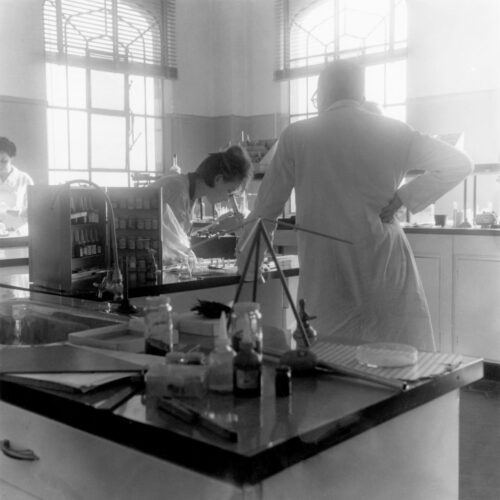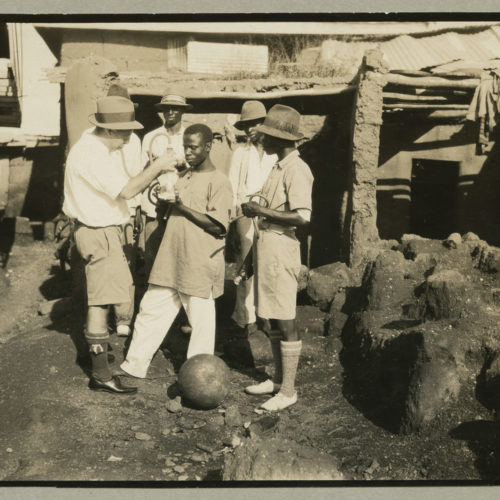Beginning in 1915, the International Health Division, a part of the Rockefeller Foundation, focused a significant portion of its money and energy on an attempt to eradicate malaria. A potentially fatal parasitical disease transmitted by mosquitoes, malaria affected large areas of the world in the early 20th century. In fact, the very factors that made malaria so imposing, widespread areas of infection and high fatality rates, made it a compelling target for Foundation’s new international public health efforts.
In 1917 the RF began experiments in Mississippi and Arkansas aimed at evaluating the best means to combat malaria. Scientists researched four methods to control the disease:
- Using quinine to sterilize the blood of persons already infected with malaria
- Giving preventative quinine to persons who had not contracted the disease
- Installing screens in the windows of buildings in affected areas
- Eliminating or controlling mosquito breeding grounds through drainage techniquesRockefeller Foundation Annual Report, 1917
The Rockefeller Foundation achieved notable success in the fight against malaria. In 1940, the anopheles gambiae, a species of malaria-carrying mosquito that had traveled from Africa, was eradicated from a controlled area in Brazil through intensive efforts led by RF program officer Fred Soper. This goal was reached with an investment of $430,000 over three years and with the use of Paris green, a larvicide discovered in the 1920s that allowed for targeted fumigation of the anopheles breed. Specific mosquito breeds were eradicated in a major Egyptian campaign in 1946 and during the Sardinian Campaign from 1946-1951.
Malaria: The Italian Campaigns
It seems to me that in an eradication program one has to hit hard with everything at one’s disposal and, on that basis, I believe that the chances of success are excellent.
Paul F. Russell, MD to Dr. John A. Logan, 1948F. Russell, M.D. to Dr. John A. Logan, February 18, 1948, Rockefeller Archive Center (RAC), RG 1.2, Series 700, Box 13, File 113.
In the 1930s, 70,000 inhabitants on the Italian island of Sardinia were infected with malaria. By the 1950s only three or four cases persisted on the island.Marcus Hall, “Today Sardinia, Tomorrow the World: Malaria, the Rockefeller Foundation, and Mosquito Eradication”, Rockefeller Archive Center Research Reports, 2004. This reduction can be attributed in large measure to Rockefeller Foundation (RF) strategies in combating the disease. In addition to its success, the Sardinian campaign is notable for groundbreaking techniques, including the first use of DDT to target mosquitoes and their breeding grounds. The campaign is also important for the debate it engendered on disease eradication versus control – a debate that continues to echo throughout the modern field of public health.
Malaria had long affected Italy, particularly the southern and coastal regions. Before RF involvement the Italian Government distributed quinine to at-risk populations. Benito Mussolini also ordered a series of land-reclamation projects intended to develop marshlands where mosquitoes were known to breed.
The Rockefeller Foundation’s Italian campaign against malaria began in 1924 and continued until the outbreak of World War II. In 1936 RF funding helped to construct a malaria laboratory at the Institute of Public Health in Rome. While early initiatives in Italy were successful, the RF believed that the future of malaria prevention rested on mosquito eradication, an idea first advocated by Soper, an epidemiologist by training.
The Sardinian Experiment
In the post-war era the Italian campaign against malaria was reorganized with a particular focus on Sardinia. The RF concentrated efforts there from 1946 to 1951. The goal was the complete eradication of the anopheline mosquito responsible for malaria transmission. The Sardinian campaign was viewed by those within the RF as an experiment. Sardinia, a secluded island with high rates of malaria infection, became the perfect laboratory to study the feasibility of eradication. RF scientists also planned to use dichlorodiphenyltrichloroethane, or DDT, a powerful chemical insecticide that first proved effective in fighting typhus during World War II.
The Sardinian campaign depended on RF money and expertise, along with significant financial and technical support from the Italian Government and the United Nations Relief and Reconstruction Administration (UNRRA). Ten thousand tons of DDT were deployed in Sardinia by 32,000 sprayers.Marcus Hall, “Today Sardinia, Tomorrow the World: Malaria, the Rockefeller Foundation, and Mosquito Eradication.” Rockefeller Archive Center Research Reports, 2004.
The end results were impressive. Officials cited a 99.9% rate of success in eradicating the dangerous mosquito from the island.Marcus Hall, “Today Sardinia, Tomorrow the World: Malaria, the Rockefeller Foundation, and Mosquito Eradication.” Rockefeller Archive Center Research Reports, 2004.
Eradication vs. Control
Critics argued that the RF campaign was unnecessarily broad in scope, that species eradication was ecologically dangerous and that similarly successful results could have been achieved through more targeted mosquito control. John Austin Kerr, the first superintendent of the Sardinian campaign, numbered among these critics. In June 1946 Kerr questioned the feasibility of mosquito eradication, writing to Soper that “[a]fter spending a week in Sardinia I am of the opinion that the aim of the project there should be changed from eradiation of anopheles to the eradication of malaria.”J.A.Kerr to Dr. Fred L. Soper, June 6, 1946, RAC, RG 1.2, Series 700, Box 12, File 104. Kerr cautioned against the costs and overuse of DDT, but his concerns were brushed aside by others at the RF. George K. Strode, Director of the International Health Division, wrote to Soper,
I see no point in carrying out the Sardinian project unless it is aimed at anopheline eradication and I agree that we should stick to our guns in reference to that objective.
George K. Strode, 1946George K. Strode to Dr. Fred L. Soper, June 26, 1946, RAC, RG 1.2, Series 700, Box 12, File 104.
The debate ultimately led to Kerr’s resignation one year later.
The commitment to fight malaria proved long-lasting. In 1998, the Rockefeller Foundation launched initiatives to develop private-public partnerships aimed at targeting diseases of poverty, including malaria in Africa. In 1999, the Foundation was a key donor of the Medicines for Malaria Venture, a partnership with the governments of Switzerland and the Netherlands, the World Bank and the UK Department for International Development.
Research This Topic in the Archives
Explore this topic by viewing records, many of which are digitized, through our online archival discovery system.
- “Arkansas – Malaria – Reports,” 1916-1917. Rockefeller Foundation records, International Health Board/Division records, Record Group 5, Routine Reports, Series 3, Arkansas – Malaria, Subseries 3_204_I, Rockefeller Archive Center.
- “Mississippi – Malaria, Bolivar County, Weekly Reports,” 1916. Rockefeller Foundation records, International Health Board/Division records, Record Group 5, Routine Reports, Series 3, Mississippi – Malaria, Subseries 3_227_I, Rockefeller Archive Center.
- “Mississippi – Malaria, Annual Report,” 1922. Rockefeller Foundation records, International Health Board/Division records, Record Group 5, Routine Reports, Series 3, Mississippi – Malaria, Subseries 3_227_I, Rockefeller Archive Center.
- “Reports – Mississippi – Malaria,” 1923. Rockefeller Foundation records, International Health Board/Division records, Record Group 5, Routine Reports, Series 3, Mississippi – Malaria, Subseries 3_227_I, Rockefeller Archive Center.
- “Rockefeller Foundation Health Commission – Typhus-Malaria,” 1944 February-1947 April. Rockefeller Foundation records, Projects (Grants), Record Group 1, Subgroup 1.2, Europe, Series 700, General (No Program), Subseries 700.GEN, Rockefeller Archive Center.
- “Rockefeller Foundation Health Commission – Typhus-Malaria,” 1947 May-1949 April. Rockefeller Foundation records, Projects (Grants), Record Group 1, Subgroup 1.2, Europe, Series 700, General (No Program), Subseries 700.GEN, Rockefeller Archive Center.
- “Russell, Paul Fass (Reports on Malaria Tours in India),” 1934-1935. Rockefeller Foundation records, Photographs, India, Series 464, Medical Sciences, Subseries 464.A, Rockefeller Archive Center.
- “Malaria,” circa 1905-1980. Rockefeller Foundation records, Photographs, Greece, Series 749, Malaria, Subseries 749.I, Rockefeller Archive Center.
- “Malaria – 2,” 1925-1937, 1947. Rockefeller Foundation records, Photographs, Italy, Series 751, Malaria, Subseries 751.I, Rockefeller Archive Center.
- “‘Field Studies in Palestine’ – Carley, Paul S.,” 1922. Rockefeller Foundation records, Photographs, Israel, Series 825, Malaria, Subseries 825.I, Rockefeller Archive Center.
The Rockefeller Archive Center originally published this content in 2013 as part of an online exhibit called 100 Years: The Rockefeller Foundation (later retitled The Rockefeller Foundation. A Digital History). It was migrated to its current home on RE:source in 2022.

